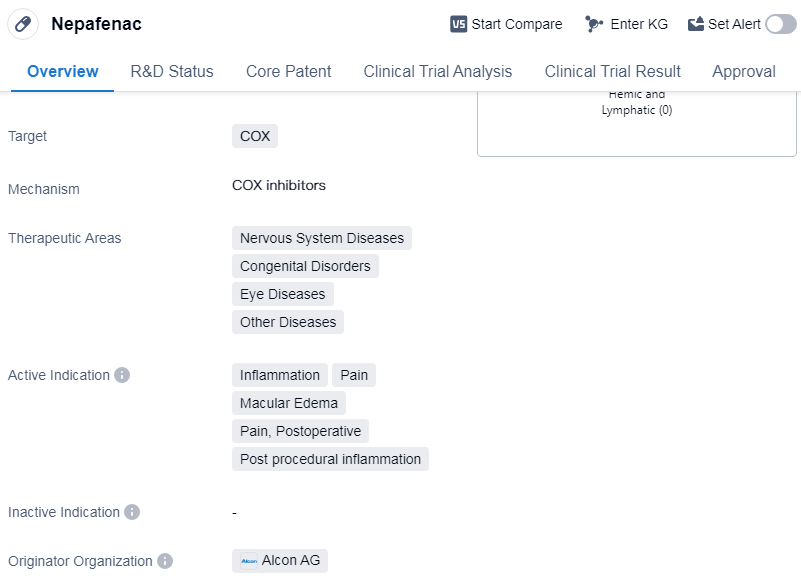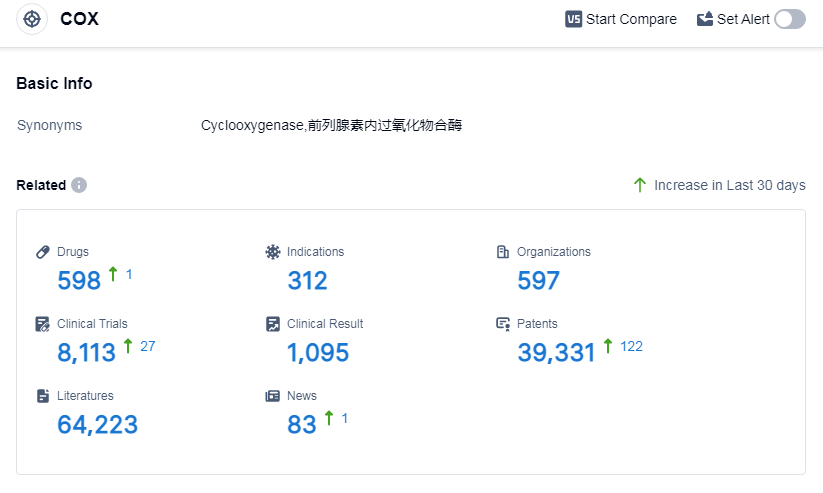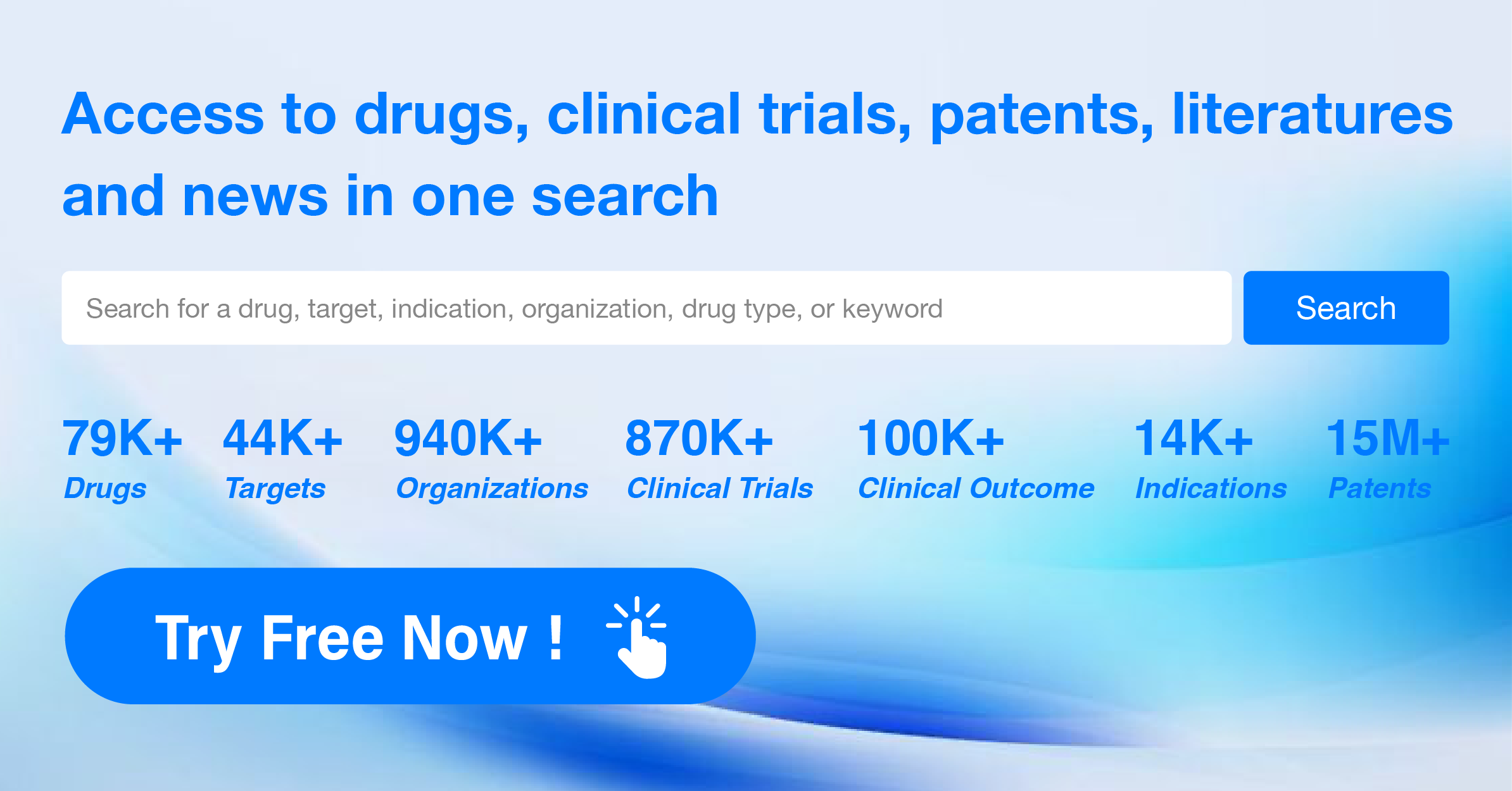A Comprehensive Review of Nepafenac's R&D Innovations and Drug Target Mechanism
Nepafenac's R&D Progress
Nepafenac is a small molecule drug that belongs to the class of nonsteroidal anti-inflammatory drugs (NSAIDs). It primarily targets the enzyme cyclooxygenase (COX), which plays a crucial role in the production of inflammatory mediators. By inhibiting COX, Nepafenac helps reduce inflammation and alleviate pain associated with various conditions.
The therapeutic areas in which Nepafenac is indicated include nervous system diseases, congenital disorders, eye diseases, and other diseases. It is specifically used to treat inflammation, pain, macular edema, postoperative pain, and post-procedural inflammation. These conditions can arise from a variety of causes, such as surgery, trauma, or underlying diseases.
As a small molecule drug, Nepafenac is likely administered orally or topically, allowing for convenient and targeted delivery to the affected areas. Its approval for multiple indications suggests its versatility and effectiveness in treating various inflammatory conditions.
Nepafenac was first approved for use in the United States in August 2005 and it received global approval at the same time, which marked an important milestone in the pharmaceutical industry, providing healthcare professionals with a valuable tool in managing inflammation and associated symptoms.
Nepafenac was developed by Alcon AG, a pharmaceutical company specializing in eye care products and treatments.Its use in treating eye diseases, in particular, highlights its potential in addressing ocular conditions that can significantly impact vision and quality of life.
👇Please click on the image below to directly access the latest data (R&D Status | Core Patent | Clinical Trial | Approval status in Global countries) of this drug.
Mechanism of Action for Nepafenac: COX inhibitors
COX inhibitors are a type of medication that act on the enzyme COX. This enzyme is responsible for the production of prostaglandins, which are chemical messengers involved in inflammation, pain, and fever. COX inhibitors work by blocking the activity of COX, thereby reducing the production of prostaglandins.
From a biomedical perspective, COX inhibitors are commonly used as NSAIDs to relieve pain, reduce inflammation, and lower fever. They are often prescribed for conditions such as arthritis, menstrual cramps, and headaches. By inhibiting COX, these medications help to alleviate symptoms associated with inflammation and pain.
There are two types of COX enzymes: COX-1 and COX-2. Traditional COX inhibitors, such as aspirin and ibuprofen, inhibit both COX-1 and COX-2 enzymes. However, selective COX-2 inhibitors, such as celecoxib, specifically target the COX-2 enzyme while sparing COX-1. This selectivity reduces the risk of gastrointestinal side effects commonly associated with traditional COX inhibitors.
It is important to note that while COX inhibitors can provide relief from pain and inflammation, they may also have potential side effects. These can include gastrointestinal issues like stomach ulcers and bleeding, as well as an increased risk of cardiovascular events. Therefore, it is crucial to use COX inhibitors under the guidance of a healthcare professional and follow the prescribed dosage and duration of treatment.
Drug Target R&D Trends for Nepafenac
According to Patsnap Synapse, as of 15 Sep 2023, there are a total of 598 COX drugs worldwide, from 597 organizations, covering 312 indications, and conducting 8113 clinical trials.
The analysis of the target COX reveals a competitive landscape with multiple companies actively involved in the research and development of drugs targeting COX. GSK Plc, Viatris Inc., and Pfizer Inc. are the leading companies in terms of drug development and approval. Pain is the most common indication for approved drugs, followed by common cold, rheumatoid arthritis, and osteoarthritis. Small molecule drugs dominate the drug types progressing rapidly under the target COX, indicating intense competition and continuous innovation. China is emerging as a key player in COX inhibitor development, with the highest number of approved drugs. The future development of target COX is expected to witness further advancements in drug development, expansion of therapeutic indications, and increased global collaboration in research and development efforts.
👇Please click on the picture link below for free registration or log in directly if you have a freemium account, you can browse the latest research progress on drugs, indications, organizations, clinical trials, clinical results, and drug patents related to this target
Conclusion
In summary, Nepafenac is a small molecule drug developed by Alcon AG that targets COX and is approved for use in treating inflammation, pain, macular edema, postoperative pain, and post-procedural inflammation. Its approval in 2005 and its broad therapeutic areas indicate its significance in the field of biomedicine, particularly in the treatment of eye diseases and other inflammatory conditions.






